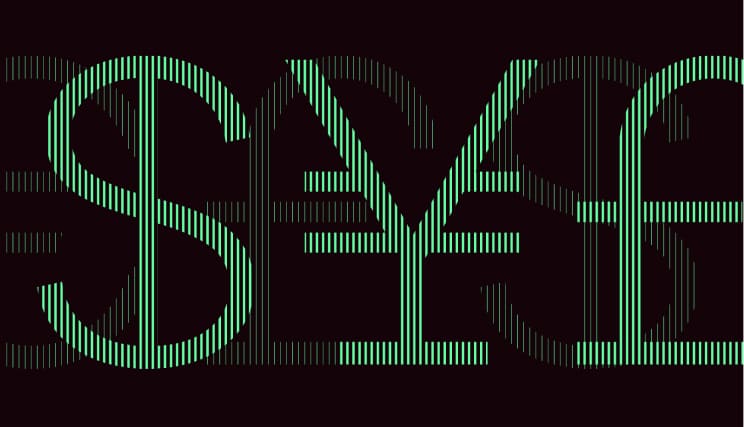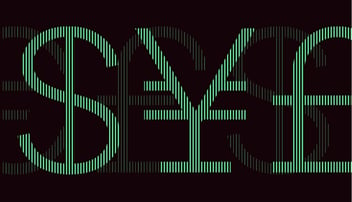Gain an overview of the latest developments on the currency market and anticipate fluctuation risks.
Monetary chaos ahead?
Barring a last-minute surprise, the currencies of the big Western economies will follow a clear trajectory in the short term. The European Central Bank (ECB), the Bank of Canada (BoC), the Federal Reserve (Fed) and the Swiss National Bank (SNB) are all expected to cut their interest rates next June. This marks the return of monetary policy coordination. In Asia, the situation is more complicated. This is where all eyes will need to be focused in the weeks ahead. In Japan, the authorities are opening the door to a possible intervention to slow the yen’s depreciation. In China, the government is conveying contradictory signals about its intentions for the yuan – depreciation or appreciation, who knows? Beware a resurgence of volatility!
EUR/USD
Haut: 1,0960 Bas: 1.0725 Variation: -1.01%
The consensus among economists is a no-landing scenario for the US economy (i.e. no recession). Growth is forecast at close to 2.2% this year and inflation at 3%. All this supports the scenario of rate cuts by the Fed starting in June, but only in small increments as there is no hurry to boost the US economy. Jerome Powell, its chairman, forecasts three rate cuts this year for a total of 75 basis points. This makes sense and is in line with our expectations. At this stage; we do not expect it to weaken the US dollar. The strong dollar is likely to be a constant feature in 2024.
EUR/GBP
Haut: 0.8586 Bas: 0.8503 Variation: -0.08%
The money market thinks there is a 56% probability that the Bank of England will cut its base rate by 25 basis points in June. This is not yet a done deal. From the currency pair’s perspective, this does not change things. As in previous months, it continues to move within a range.
GBP/USD
Haut: 1,2895 Bas: 1.2542 Variation: -0.98%
The breach of the support line at 1.27 confirms the downward bias in the short term. Overall, the market continues to have a long position in the US dollar, which also has repercussions for the GBP/USD pair. It is not unlikely that we will see a return to the zone around 1.2650, creating a potentially attractive entry point for buyers.
EUR/CNH
Haut: 7.8858 Bas: 7.7821 Variation: +2.51%
It is hard to understand what China is seeking to do with its currency. In recent months, the yuan has tended to weaken. This makes sense as it provides a stimulus for exports – the principal driver of the economy. Over approximately the past week, however, China, through state-controlled commercial banks, has intervened to prop up the yuan, which has crossed the threshold of 7.20 against the US dollar. It would seem – and we say this tentatively – that Beijing is seeking in the short term to stabilise the USD/CNH around this level. Caution is therefore necessary. In the past, the instability of the Chinese currency, including against the euro, has systematically sent economic and financial tremors across the world.
EUR/CHF
Haut: 0,9817 Bas: 0.9512 Variation: +1.61%
Surprise, surprise! Only a minority of investors saw it coming. The SNB took the market off guard by trimming its policy rate by 25 basis points to 1.50% in March. A similar cut is planned in June. Although this needs confirming, the SNB is also likely to continue intervening in the currency market to buy francs. All this points to a continued rally by the EUR/CHF. A return to parity is no longer a fanciful scenario.
EUR/CAD
High: 1.4741 Low: 1.4472 Change: +1.21%
The pair’s underlying trend has not changed since last month: it continues on an upward path. According to the money market, there is an 80% probability that the BoC will cut its policy rate by 25 basis points in June. In our view, this is unlikely to modify the trajectory of the EUR/CAD pair because of the monetary policy coordination at work.
EUR/AUD
Haut: 1.4762 Bas: 1.4555 Variation: -1.15%
Currency traders have never had such massive short positions in the Australian dollar, according to the latest weekly Commitment of Traders report by the CFTC (the equivalent of the US stock market regulator). This is unprecedented. Uncertainty surrounding Australian monetary policy largely explains this bearish bet by investors. The central bank’s last report underlined that a rate hike is just as possible as a rate cut. This is also a reminder that the battle against inflation is sometimes more complicated than initially expected in some regions.
EUR/JPY
Haut: 165.36 Bas: 160.21 Variation: -0.26%
It was only to be expected. The Japanese yen reached its lowest level against the US dollar since 1990 last week. The Japanese authorities subsequently expressed their concerns about excessive exchange-rate fluctuations. For the time being, Japan’s interventions are only verbal, but if the yen continues to weaken we can expect it to intervene directly in the currency market. History reminds us that exchange-rate interventions are only effective for long if they are coordinated. As such, the US would also need to intervene, which is unlikely. We therefore continue to think the yen will remain relatively weak for much of the year. The Japanese currency’s real effective exchange rate is at its late 1970s lows.
EUR/HUF
Haut: 399.71 Bas: 391.89 Variation: -0.25%
According to technical analysis, a test of the zone around 400 cannot be ruled out in the medium term. Nonetheless, we doubt the pair can go above this in the near term. Instead, we expect it to stabilise at between 390 and 400 over the coming months. Monetary policy is unlikely to be a differentiating factor for the pair in the short term. The downward trajectory of Hungarian interest rates is not in doubt: another 75-basis point cut is probable at the central bank’s meeting on 23 April. The downward cycle may be put on hold over the summer, in our view.
USD/HUF
Haut: 368.83 Bas: 358.13 Variation: +1.01%
One thing never changes in the currency market: the strength of the dollar. This resilience is due to many factors, an important one being the high level of US interest rates. While we are not among those who expect the greenback to enter a several year-long downward cycle in the months ahead, it is not unlikely that the dollar exchange rate will weaken slightly as liquidity decreases in the financial markets. This is usually a leading indicator of a fall in the dollar. Although it has not been verified systematically in the past, this is a point worth watching.
Economic Calendar
| DATE | CURRENCY | EVENT |
| 03/04 | EUR |
Eurozone inflation in March (1st estimate) |
| 04-05/03 | CNH | Public holidays |
| 05/03 | USD | US report on employment and unemployment |
| 10/03 | USD |
Inflation in March (1st estimate)
|
| 10/03 | CAD |
Central bank meeting |
| 11/04 | EUR |
Central bank meeting |
| 11/04 | USD |
Producer prices in March |
| 23/04 | HUF |
Central bank meeting |
| 26/04 | JPY |
Central bank meeting |
Topics




